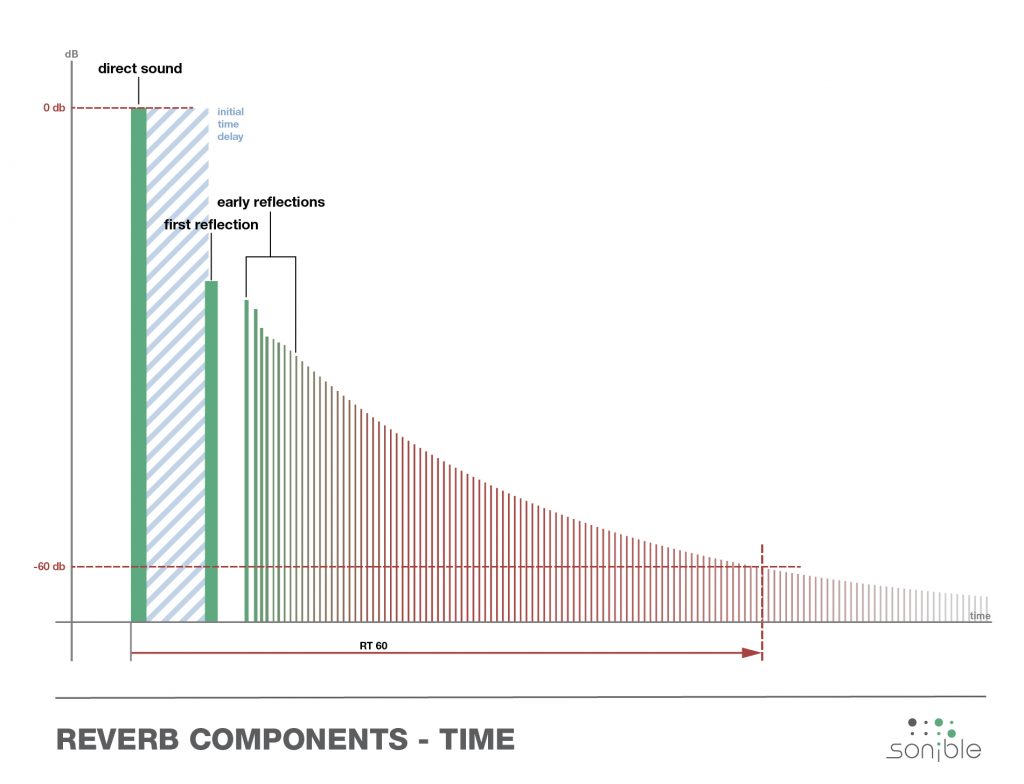Each reverb is built from distinguishable components: the direct signal, first reflection, early reflections and the reverb tail. These all carry different information that we then perceive. We want to show you why reverb isn’t just a pretty effect but rather, it is something crucial to our perception. As well, we will explain what you need to consider when using reverb in audio production.
The components of reverb determine how our brain interprets what we hear. For example, early reflections give us a comprehensive impression of the room (its size and geometry), the surfaces we are surrounded by and how far away the sound source is. The reverb tail however, is more about embedding and enveloping and validates what we have interpreted from the early reflections. When it comes to using reverb in audio production, we need to keep all of this in mind. But let’s start with the basics. Here is a short breakdown of the reverb components and their technical aspects (read more about reverb in article “Reverb in audio production“).

Every audio reflection that reaches our eardrums within 10ms after the direct signal is combined with the original, direct sound. First reflections can amplify the signal and add color to it, but they can also produce undesirable comb filter effects. As sound travels at a speed of approx. 343 m/s, it has therefore travelled around 3,5 meters after 10ms.
Audio reflections that reach our ears 10 – 50 ms after the direct signal provide us with a lot of information about the nature of a room – its size, its surfaces and indications of its shape. The temporal difference between early reflections and diffuse reverberation also contains important information about the listener’s distance from the sound source.
Every reflection that we hear later than ~ 50 ms after the direct signal is added to what we typically call reverberation (also known as decay, diffuse sound or reverb tail). The “tail” embeds the original sound into a soundscape and can render it indistinct if strong enough. The sonic character of the reverberation depends also on the reflective qualities of the space’s surfaces.
Considering the properties of different reverb components, finding the right parameters of the envisioned reverb for an audio track can quickly become immensely time-consuming whilst mixing. As well, reverb is a lot about conveying a feeling. Bringing together technical aspects and affective intentions can be quite tricky. There is a lot to be gained by using reverb but there are also several things you want to avoid. Here are a few general examples of the latter when adding reverb:
When we start with a new creation, we usually have an idea about how it should sound. The hard part is to actually stick to your initial goal. You can lose your aim anytime during your workflow and reverb certainly isn’t an exception. By rummaging around a large number of presets on your way to finding the perfect reverb, your original idea can quickly become wishy-washy and in the end you may have invested a lot of time only to lose track of your sonic vision.
Pro tip: Do an A/B comparison. Rely on your intuition and choose an initial reverb preset that comes close to your idea and save it as A. Then explore different reverb presets and settings. Save the one you think is finally the right one as B. It is astonishing how our initial choice is often the best one because our ears fatigue while listening to all those different reverb options.
With an aesthetic vision in mind but no preset that truly fits, you need to manually tackle all the different reverb parameters. Their interrelated nature makes this a little tricky because you basically have to describe a feeling via different properties such as size, decay, type, diffusion etc. and our brain will tell us that there is something wrong if the components of a reverb are not conclusive in their relations to each other. This is particularly true if you want things to sound natural.
Pro tip: The “right” reverb parameters strongly depend on the genre your music belongs to. For example, reverb for tracks in classical music, folk, country, etc. needs to be specifically coherent and sound natural most of the time. Artificial sounds and more experimental settings work well in genres like pop, metal and EDM.
There is a tendency to compensate for a problematic reverb that isn’t sounding right by making it more imposing. This often results in a very muddy sound.
Reverb is an effect that has a lot of power but it also is something that has the potential to quickly muddy your creation – and this already begins with your input material. If you use a reverb that is not really suitable for the source material you are working with, it will amplify unwanted resonances and make your audio sound hazy. This results in masking, muddiness and causes a smeared direct sound. Take a vocal track for example: When the tail is too long and thick-sounding and there isn’t enough pre-delay, the sound becomes blurry. The vocal will sound imprecise, intangible and ultimately loses what should have been gained by adding reverb: radiance and presence.